calsfoundation@cals.org
Davidsonville Historic State Park
| Location: | Randolph County |
| Area: | 163 acres |
Davidsonville Historic State Park is a 163-acre park located on the Black River in southern Randolph County. The park preserves the site of the town of Davidsonville, which housed the first postal stop, the first courthouse building and county seat of Lawrence County, and the first federal land office in what is now the state of Arkansas.
The town was created from a few log cabins in 1815, when the Act of Lawrence County was written; it was briefly known as the town of Lawrence. Strangely, this town of “firsts” was also the first county seat to be bypassed by a major road connecting Missouri to the Great Southwest. By 1829, Davidsonville had lost the courthouse to Jackson and the land office to Batesville (now in Independence County). The movement of these buildings caused the town to lose importance and fall into obscurity and legend. Today, the park around its remains attracts a wide range of outdoor enthusiasts and historians.
The park site is situated at the very edge of the Ozark Plateau, on the banks of the Black River. The Mississippi Delta, a rich agricultural region stretching hundreds of miles along the Mississippi River, is located across the river, and the rocky Salem Plateau section of the Ozarks begins just west of the park. Archaeologists consider Davidsonville special because the town, established around the same time as Memphis and St. Louis Railroad, did not evolve and undergo extensive and continual rebuilding. The artifacts have been relatively undisturbed, which is rare for this time frame.
Transitory Native Americans used the high ground where Davidsonville was founded long before French traders arrived and claimed the land. The town site was purchased from Joseph Janis, John Fagas, Cola LeCombe, Jerome Mattix, and Augustus Revitt and transferred to the new county on December 16, 1815.
The Missouri territorial legislature created Lawrence County on January 15, 1815. At the time, the county covered much of northern Arkansas and a part of southern Missouri. The southern boundary was the Arkansas River. More than thirty percent of Arkansas counties were carved from the original Lawrence County. In 1818, when the Missouri Territory applied to become a state, the land that is now Arkansas was made a separate territory.
Davidsonville was named for John Davidson, a North Carolina native who represented the new county in the 1816 Missouri legislature. When the postal stop was established on June 28, 1817, it was also named in Davidson’s honor. Within a few weeks, Arkansas Post (Arkansas County) became the second post office in what is now Arkansas.
In 1822, the first Arkansas courthouse, a two-story brick structure, was completed at Davidsonville. (Oddly enough, the act that established Lawrence County stated that money raised was to build a jail first, with money left over going to the courthouse.) Two years later, the first U.S. Land Office opened, and the U.S. Census reported that Davidson Township, including the town of Davidsonville, had 461 residents. On March 2, 1819, Arkansas became a separate territory and established its own capital at Arkansas Post.
Periodically, Congress approved funds for road improvements in Arkansas. The U.S. Army carried out this work; thus, the trails were often called military roads. One of the road projects in the late 1820s—moving the existing Southwest Trail out of the swamps—bypassed Davidsonville to the west, and a new town called Jackson sprang up on the new section of road directly across the river from what is now Imboden (Lawrence County). Davidsonville had relied on its function as a river port and resting area along the Southwest Trail. When the traffic and trade stopped, so did Davidsonville’s future. The U.S. Land Office moved to Batesville in 1820, and the county seat was lost to the new town of Jackson in 1829. Within a few short years, Davidsonville became a ghost town.
A renewed interest in Arkansas history during the early twentieth century focused in part on the state’s first settlements. Arkansas Post was preserved by Act 57 in 1929 and became a national monument in 1964. Legislative Act 418 approved the preservation of Old Davidsonville on March 28, 1957. Although approved in 1957, the land for Old Davidsonville State Park was not acquired until May 5, 1959. On January 18, 1974, the site was added to the National Register of Historic Places. Funding to develop the park was not appropriated until 1979. By 1987, the park had dedicated new campgrounds, picnic areas, a nature trail, pavilions, a twelve-acre fishing lake, and a modern visitor center, all located outside the old town site. The site—now called Historic Davidsonville State Park—includes historical markers, a walking trail at the old village, and two pioneer cemeteries. In 2014, the park added two “ghost structures,” open frameworks that outline the appearance of a two-story dogtrot-style dwelling and the two-story courthouse. Two years later, the park opened a new visitors center.
The park offers several events during the year, including the annual fishing tournament in April, the Ghosts of Old Davidsonville program in mid-October, and the biannual Black River Rendezvous in September. Ghosts of Old Davidsonville is a yearly one-night event held for Halloween. It includes live music, concessions, a bonfire, and hayrides through the historic townsite, where reenactors portray ghosts of people who might have lived and died during the time of Davidsonville. During the Black River Rendezvous, there are presentations of mountain-man and Native American encampments and traders, as well as various other reenactors and demonstrators.
For additional information:
Arkansas State Parks–Davidsonville Historic Sate Park. http://www.arkansasstateparks.com/olddavidsonville/ (accessed October 30, 2020).
Cande, Kathleen H. “Rediscovering Davidsonville, Arkansas’s First County Seat Town, 1815–1830.” Arkansas Historical Quarterly 67 (Winter 2008): 342–358.
Dollar, Clyde D. An Archeological Assessment of Historic Davidsonville, Arkansas. Fayetteville: Arkansas Archeological Survey Publications, 1997.
Schnedler, Jack. “Park Depicts Daily Life of Lost Black River Ghost Town.” Arkansas Democrat-Gazette, May 7, 2019, pp. 1E, 3E.
Stewart-Abernathy, Leslie C. The Seat of Justice, 1815–1830: An Archeological Reconnaissance of Davidsonville, 1979.Fayetteville: Arkansas Archeological Survey Publications, 1980.
Staff of the Arkansas Department of Parks and Tourism
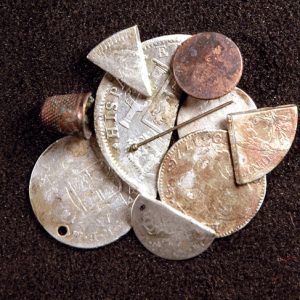 Davidsonville Artifacts
Davidsonville Artifacts 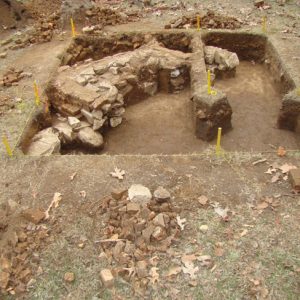 Davidsonville Excavation
Davidsonville Excavation 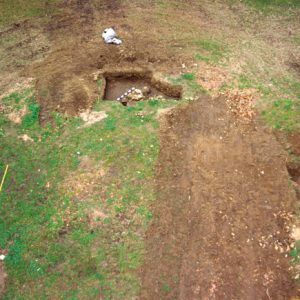 Davidsonville Courthouse Remains
Davidsonville Courthouse Remains 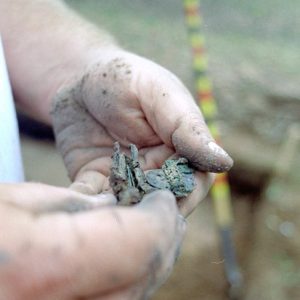 Davidsonville Artifact
Davidsonville Artifact 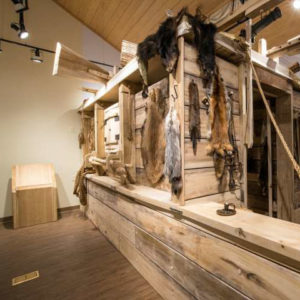 Davidsonville Exhibit
Davidsonville Exhibit 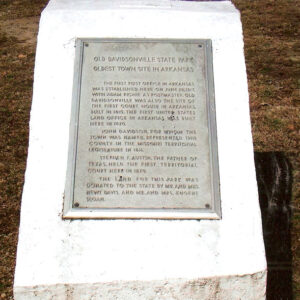 Davidsonville Plaque
Davidsonville Plaque 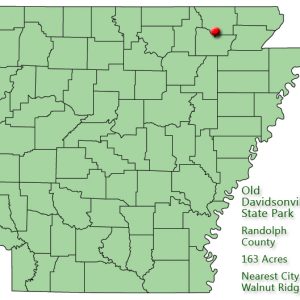 Davidsonville Historic State Park: Park Location
Davidsonville Historic State Park: Park Location  Davidsonville Park Ghost Structure
Davidsonville Park Ghost Structure  Wampum Beads
Wampum Beads 




Comments
No comments on this entry yet.